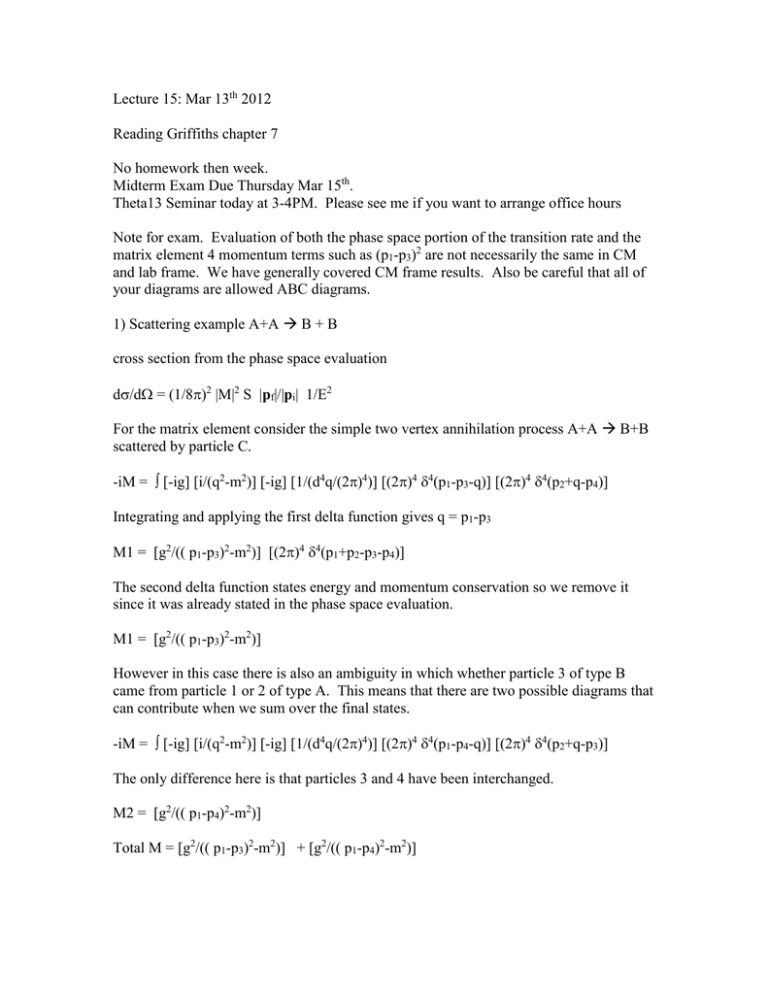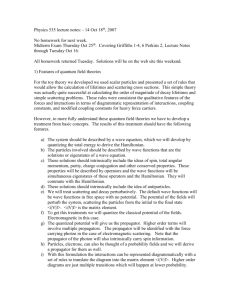lecturenotes2012_15
advertisement

Lecture 15: Mar 13th 2012 Reading Griffiths chapter 7 No homework then week. Midterm Exam Due Thursday Mar 15th. Theta13 Seminar today at 3-4PM. Please see me if you want to arrange office hours Note for exam. Evaluation of both the phase space portion of the transition rate and the matrix element 4 momentum terms such as (p1-p3)2 are not necessarily the same in CM and lab frame. We have generally covered CM frame results. Also be careful that all of your diagrams are allowed ABC diagrams. 1) Scattering example A+A B + B cross section from the phase space evaluation d/d = (1/8)2 |M|2 S |pf|/|pi| 1/E2 For the matrix element consider the simple two vertex annihilation process A+A B+B scattered by particle C. -iM = [-ig] [i/(q2-m2)] [-ig] [1/(d4q/(2)4)] [(2)4 4(p1-p3-q)] [(2)4 4(p2+q-p4)] Integrating and applying the first delta function gives q = p1-p3 M1 = [g2/(( p1-p3)2-m2)] [(2)4 4(p1+p2-p3-p4)] The second delta function states energy and momentum conservation so we remove it since it was already stated in the phase space evaluation. M1 = [g2/(( p1-p3)2-m2)] However in this case there is also an ambiguity in which whether particle 3 of type B came from particle 1 or 2 of type A. This means that there are two possible diagrams that can contribute when we sum over the final states. -iM = [-ig] [i/(q2-m2)] [-ig] [1/(d4q/(2)4)] [(2)4 4(p1-p4-q)] [(2)4 4(p2+q-p3)] The only difference here is that particles 3 and 4 have been interchanged. M2 = [g2/(( p1-p4)2-m2)] Total M = [g2/(( p1-p3)2-m2)] + [g2/(( p1-p4)2-m2)] Now evaluate for masses of A and B of m and a massless particle C. e-e- scattering via a photon ( p1-p3)2 = p12 + p32 – 2p1.p3 = E12 + E32 – p12 – p32 – 2E1E3 + p1.p13 But in CM E1=E3 and | p1| = | p3| = |p| ( p1-p3)2 = -2p2 (1-cosθ) ( p1-p4)2 = -2p2 (1+cosθ) M = -g2/ (p2sin2θ) d/d = (1/8)2 |M|2 S |pf|/|pi| 1/E2 d/d = (1/8)2 g4/ (p4sin4θ) ½ 1/E2 where E is the total energy of both initial or final particles. 2) We will discuss renormalization in detail in chapter 7 The key issue is that if you compute higher order diagrams in our toy theory or in real quantum electrodynamics we find that there are divergent terms proportional to the logarithm of the momentum of the propagator particle as you integrate over all possible momentums. Consider that these diagrams typically have 4 internal propagators that must be integrated over and 4 vertices that introduce delta functions. One delta function conserves overall momentum and energy conservation so only three of the propagators integrals can be performed using the delta functions leaving one that must be integrated. This integral, which can involve momentums, from zero to infinity leads to the divergent terms. 3) Features of quantum field theories For the toy theory we developed we used scalar particles and presented a set of rules that would allow the calculation of lifetimes and scattering cross sections. This simple theory was actually quite successful at calculating the order of magnitude of decay lifetimes and simple scattering problems. The results were consistent with the qualitative features of the forces and interactions. The rules used diagrammatic representation of interactions, coupling constants, propagators for virtual particles, and from the form of the propagator produced effective modified coupling constants for heavy force carriers. However, to more fully understand these quantum field theories we have to develop a treatment from basic concepts. The results of this treatment should have the following features. a) The system should be described by a wave equation, which we will develop by quantizing the total energy to derive the Hamiltonian. b) The particles involved should be described by wave functions that are the solutions or eigenstates of a wave equation. c) These solutions should intrinsically include the ideas of antiparticles, spin, total angular momentum, parity, charge conjugation and other conserved properties. These properties will be described by operators and the wave functions will be simultaneous eigenstates of these operators and the Hamiltonian. The operators will commute with the Hamiltonian. d) We will treat scattering and decay perturbatively. The default wave functions will be wave functions in free space with no potential. The potential of the fields will perturb the system, scattering the particles from the initial to the final state <i|V|f>. <i|V|f> is the matrix element. e) To find V we will quantize the classical potential of the fields using the electromagnetic field as an example. The quantized potential will give us the propagator. f) <i|V|f> will be equivalent to a lowest order Feynman diagram. Higher order terms will involve multiple propagators. The propagator will be identified with the force carrying photon in the case of electromagnetic scattering. Note that the propagator of the photon will also intrinsically include spin information. g) Particles, electrons, can also be thought of a probability fields (or potentials) and they will have a propagator for them as well. h) With this formulation the interactions can be represented diagrammatically with a set of rules to translate the diagram into the matrix element <i|V|f>. Higher order diagrams are higher order terms in the perturbative expansion with multiple transitions and will happen at lower probability for cases where the coupling constants are small. 3) Review how the Schrödinger wave equation was developed. Start with the expression for the total energy E = |p|2/2m +V Quantize by replacing E and p with the momentum and energy operators. These operators when they operate on the eigenstate wave function solutions will return the momentum and total energy of the wave function. E i ¶/ ¶t p -i then or in free space with solutions, in 1D Y(x,t) = y(x)f(t) = Ne ikxe-iwt , p= k, E= , We can see that the operator p -i And E i ¶/ ¶t extracts = E extracts k=p And the entire wave equation represents the energy and momentum relationship p2 k = w= =E 2m 2m 2 2 4) Klein-Gordon equation We want to do the same thing for a relativistic theory starting with the total energy. We will neglect any contribution from a potential since we intend to treat the effect of a potential perturbatively later on. E2 = p2 + m2 or more compactly pp - m2 = 0 Introducing a relativistic notation where there will be a sum over the indices = 1 to 4 and a negative sign for the upper indices 2-4 in order to give the proper relativistic invariant expression. Quantizing p i ¶, ¶ = ¶/ ¶ t, ¶ / ¶ x … results in the Klein-Gordon equation or 2 ¶ ¶ - m2 = 0 With a solution: f (x,t) = Ne ip×x-iEt Note that this is the one of the simplest solutions. A more general solution includes a function of the four momentum u(p). Also there is an ambiguity, since there is a solution with an overall negative sign in the exponential corresponding to the negative energy in solutions to the energy momentum equation, E=(p2-m2)1/2. This solution also doesn’t include all the features we want for relativistic particles such as spin, which is why we used a scalar wave function . However, it will let us investigate the normalization of the relativistic wave equation and the concept of antiparticles. One can define a continuity equation as the change in time of the probability density per unit volume is equal to the current of probability out of the volume: Consider multiplying the Klein Gordon -i* and subtracting the complex conjugate of the equation multiplied by -i The mass terms don’t involve operators and cancel out. After integrating by parts you get Identifying this with the continuity equation: The first term is probability density and the second the probability current j out of the volume. In four vector notation this is a complete probability current. j m = -i(f *¶ mf - f¶ mf * ) Calculating for using the wave function. = 2E|N|2 Note the factor of 2E that we identified as the density of states before. Also the factor of 2E makes the probability density element d3x Lorentz invariant. If you consider a particle in a Lorenzt boosted from space contracts since d3x d3x(1-v2)1/2. However, energy, the time like component dilates and the probability goes up making the probability density element constant. Now consider the wave functions with a negative sign in the exponential. These solutions have negative probability density! This problem can be resolved by noting two things. First, fundamentally the two energy solutions to the wave equations are independent. y(x,t) = Ne ip× x-iEt and y(x,t) = Ne ip× x +iEt. Thus it makes sense to identify them with independent particles both with energy E. This eliminates the problem that the positive energy particles would step down in energy and populate the lower available negative energy states. Second for Electricity and magnetism the fundamental element that is conserved and interacts with other particles via the photon is the charge. If you had one particle with probability density = 2E|N|2 , E positive, and one antiparticle with probability density = -2E|N|2 , then the total probability density of zero and you can annihilate them without changing the probability density and the conserved element is total charge!








